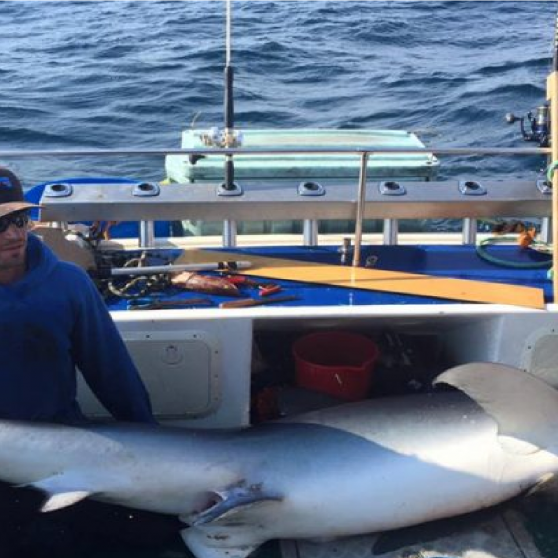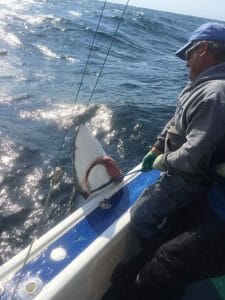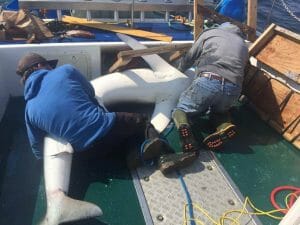
A reel big fish
An unusual day of shark tagging with Dalhousie University and the Blue Shark Charters
The time is 5:15 am and the sun is still asleep. Among the few up this early are five students, a teaching assistant and I, awaiting a seventh student.
We are the sole occupants of a deserted parking lot outside the Life Science Center at Dalhousie University. The parking lot’s lights are barely enough to illuminate the group, making out a yellow contour around the yawning faces.
Despite being up since before the break of dawn, excitement is palpable – we are about to see some sharks.
The goal of the day is to tag as many juvenile female blue sharks as possible, as part of an ongoing research project tracking the species’ migrations and behaviours in the Northwest Atlantic waters, for our summer SEASIDE course Conservation of Sharks, Skates & Rays.
The seventh student has arrived and the classmates crawl into a rental “soccer mom” car. Our TA, Becca, drives us to Eastern Passage in Dartmouth.
Once we arrive at Fisherman’s Cove in Eastern Passage, the van circles around the rows of typical harbour wooden “shacks”, on the lookout for Blue Shark Charters, where we had a rendez-vous with the boat, and captain, that would take us out on our excursion.
Unable to find the place we were looking for, we ask a couple of men chatting in the middle of the road for some directions. Apparently, we were right beside it. All I could see was a big sign that read ‘Lobster’. I was confused.
Our instructor, Manuel Dureuil, a PhD student in the Worm lab at Dalhousie, arrives minutes later with coffee and a box of Tim Horton’s donuts. Our faces gleam with appreciation under the turquoise and purple lights slowly rising above the horizon.
Soon enough, the boat is ready and we are greeted by our captain Art Gaetan (founder of Blue Shark Charters), and his trusted first mate, Nathan. Alongside them are Gaetan’s two little terrier dogs, Finn and Casey, who he affectionately calls his “little monsters.”
Gaetan has been passionate about sharks since his childhood years. He thrives on helping sharks by integrating tagging operations to his excursions and by removing nuisances such as old hooks and parasites from them. He harbors a no-kill philosophy and is very mindful of the creatures’ well-being, as they are pulled out of and released back into the water.
As we all climb onto the boat, we are given a welcome spiel with a few key points of safety: what to do in case someone falls into the water, what happens if the boat sinks, and the absolute prohibition of bananas and banana-contaminated products.
Obviously curious as to why bananas were supposedly problematic, I ask Gaetan to explain. “Not until 3”, he replies, “if we still haven’t caught something by 3 o’clock, we will start doing body searches for bananas”.
We set off for the sea as tones of orange and yellow start filling the sky. When the Nova Scotian coast was barely visible on the horizon, we stop to let ourselves drift to an area where an underwater structure is present. Bottom structures stretching vertically create currents around them, where nutrients accumulate and as a result, so do fish. The presence of higher concentrations of food meant an increased likelihood of stumbling upon a hungry shark.
While we are waiting for the drift to bring us to a shark sweet spot, Gaetan opens up about his struggle with the public’s misconceptions.
“I get nasty letters,” he confesses, “people think you’re out killing them.” For this reason, Getan had to take down the signage for Blue Shark Charters in Fisherman’s Cove, as a precautionary measure and to stop getting scathing letters, which explains the difficulty we had this morning, finding the place in the morning. “People don’t know what I do for the sharks,” expresses Gaetan, disheartened, showing us some of the hooks he had removed from past catches.
Gaetan then shared with us something quite incredible that “you have to see to believe.” When the shark first arrives on deck, its eyes are shut but the mouth stays open while the hook is being removed.
Once the hook is removed, the shark realizes you mean it no harm, it opens its eyes, looks at you, and opens its mouth again so you can remove other hooks that may have been embedded in its jaws. It’s kind of like going to the dentist: you hate it but you know the dentist is helping you so you keep your mouth wide open.
Gaetan and crew start preparing the fishing operation. Chum is dumped in the water, fishing rods put in place, and the surgery material is set out and ready for quick assembly.
We split tasks and I take on the responsibility of holding the surgical tools for our instructor Dureuil during the surgery. We are ready to roll – and now we wait.
“And now we wait” echoed in our head as time passed and the buoys on the fishing lines remained undisturbed for hours. Theories are circulating as to why our fishing operation had been fruitless so far.
Gaetan had noticed a significant drop in his catch rates from previous years, which elevates concerns in our conservation-induced minds. Was the Blue Shark population in such steep decline that there simply are no more sharks to catch in the water?
Our captain argues that the water itself was the culprit, as he points out its green colour. According to him, these may be cold, nutrient-rich waters from the Labrador Current, which are not the shark’s favorite.
Caitlin Bate, one of our fellow classmates, postulates that we may be in a particularly big shark’s territory, an underwater bully that would presumably be chasing away any smaller sharks−which meant no shark out there to smell the chum.
I noticed a big blue brick entitled Sharks of the World on the cockpit’s table, and decided to flip through it. One of the first things I read is something about sharks sometimes exhibiting “stomach eversion” when caught, a reflex to rid themselves of indigestible items, such as a hook.
A little disturbed by the imagery of this phenomenon, I retreat to further pages in the book, filled with wonderful illustrations of described shark species.
All of a sudden, there is action on deck. We have a shark. We are pulling a shark in.
My lifeguard reflexes kick in and I dash for the gloves that were maybe half a meter away. Unfortunately, minutes later, the operation is called off as the shark had freed itself from the hook. I catch a glimpse of it gracefully swimming by the boat, its blue scaly skin shimmering. It was an awe-inspiring sight.
Hours go by without any sign of underwater life. Our faces slowly elongate.
Gaetan informs us that until 1:30pm the previous day, no shark had been caught, but that several more were caught afterwards. Holding onto that slice of hope, we look down at our watches now and again, as though at that specific time, the sharks would magically hear the dinner bells and show up.
1:30pm came around, and the waters stayed motionless. We start suspecting someone sneaked some bananas on board…
Two other sharks are caught and lost and we all start to worry that we would head back to shore with the disappointment of not having seen any shark up close, let alone tag one.
It is about time to turn around when something bites the bait and it is time to shift into reeling mode again.
This time though, we were not going to lose it.
Before long, it is apparent that the shark on the line was no ordinary shark. Its weight alone made it heavy and difficult to reel in that when it decided to swim away, all the fishing line broke loose into the ocean.
It cannot be a Blue Shark or a Shortfin Mako, which is occasionally caught in our waters as well.
“Blue Sharks and Makos run away,” says Gaetan. Unlike them, this shark is using its weight to avoid being pulled up to the surface.
We were dumbfounded. Gaetan had never caught a White Shark before, but sightings in Nova Scotia have been increasing, so catching one of those remains a possibility. After all, warming ocean waters likely extended the northward range of several fish species, including the white sharks.
No matter what it is, the shark is strong and Gaetan knows it is a big one. So big, that the operation table meant for the tagging surgery is disassembled to make space on deck for the shark, as it is not sufficient to support its size and weight.
For this reason alone, we are not going to be able insert an acoustic tag in our shark. However, we are still going to be able to attach a “dart” tag with a phone number to call if it is ever caught again.
Students take turns in attempting to reel in the shark. They are working with all their might to roll the knob of the fishing rod fast enough to haul the monster shark in shallow waters, but they are no match against its strength when it decides to swim away.
I hold onto Finn and Casey, the little monsters, that have the unfortunate tendency to come say “hello” on deck, despite Gaetan’s repeated demands to stay inside.
The high level of action on deck made it particularly hazardous for these little fluffy balls to go venture out.
Forty-five minutes of fighting go by and there is still no sign of retreat from the shark. All the hope from the effort spent reeling in the shark is quickly dissipated when it swims away and “takes line”.
As our three reeling musketeers grow tired, Francheska Krysiak hops in to relieve some of the pressure. She reels, she reels, and voilà! There is our shark, visible at the surface. It is the first time we catch a visual glimpse of what we are up against, since the fight started.
As suspected, it is big. It has a “killer width”. Surprisingly though, it is a Blue Shark.

Reeling in the Blue Shark.
As quickly as it appears to us at the surface, it escapes back into the shadows of the ocean’s depths. Our reeling efforts start over for the umpteenth time.
After about one hour of tug-o-war with our shark, we finally won. I propped my head out of the captain’s seat window to have a peek at it; my heart sinks as our shark floats motionless, belly up, stomach… everted.
Thankfully, the shark was not dead. It is called a “tonic response”, or playing dead. Gaetan triggered the tonic response when he rubbed the shark’s nose. He had it “play dead” while it was pulled up and set on the deck. This not only made the handling easier, but also safer for both the shark and us.
Sharks can bend like wishbones due to their cartilaginous body. It may be straight one second, but the next, the snout could be touching its tail.

Shark going into “wishbone” position.
As the shark finally gave in, everyone participating in the pulling effort fell back on themselves, giving sight to the shark’s snout and large pointy teeth creeping above the sides of the boat and onto the deck.
After one hour of pulling, there it was, thrashing its 12-foot body on the 11-foot deck.
Despite having been triggered into a tonic state, a student grabs the tail, Gaetan grabs the head, and then another student takes control of the shark’s mid body. Everyone else was shooed into the cockpit.
Quickly, measurements were taken of length and girth. We inserted the dart tag at the bottom of its first dorsal fin, and then we each took turns to look into the shark’s eyes.
Measurements should always be taken regardless of the catch, but more specifically with the Blue Sharks, we were told that we should look into its eyes. Professor Dureuil had expressed countless times how beautiful Blue Sharks’ eyes were, and he really wanted each and every one of us to experience the magic of connecting with them.
In and out. Students fished only one shark but they fished a hell of a big shark.
Captain Gaetan of Blue Sharks Charters was convinced it was the biggest Blue Shark he had fished yet, and quickly fit the length and girth measurement into a size-weight model.
According to the mathematical model for Blue Sharks, the catch was approximately four hundred and fifty pounds in weight.
Four hundred and fifty pounds. That was definitely the biggest Blue Shark Gaetan had ever fished. Four hundred and fifty pounds is approximately 2.5 people. While the shark was not quite big enough to hold the Nova Scotian record of four hundred and sixty-one pounds, it could likely hold the second place.
It was past 3 o’clock when the big shark saga was over and students headed back to shore.
Captain Gaetan accepts to tell us the story of the bananas, which is better left untold.
Patting ourselves on the back and sharing stories of what was rummaging through our minds in the heat of the hour-long “moment”, I notice one of my fellow classmates hunched over the edge of the boat.
Indeed, for some, that hour had been a long one; the whole day had been terribly long. Sea sickness does not take a break and some of the students were feeling its wrath, enduring the never-ending rummaging in their guts.
Regardless of the physical state of the students, all said they felt tired and dirty but were quite happy with the unexpected turnout of our day.
They may not have been able to tag a shark the way they wanted to that day, but the purpose of the excursion remains an important one.
Sharks are some of the oldest creatures roaming the planet and play an important role in maintaining balance in our oceanic ecosystems. Their global number collapses in populations worldwide indicate that they may soon no longer be around to maintain that balance.
The Blue Shark is one of the most abundant sharks in our waters, yet little is known about it. Tracking them via tagging methods is one of the ways scientists can help the public understand the species more.
Beyond research projects with Dalhousie, Blue Shark Charters also tags sharks for the Bedford Institute of Oceanography and the APEX Predator Program. Ultimately, by Blue Shark Charters helping groups save the sharks, they are helping the preservation of the species−one tag at a time.






